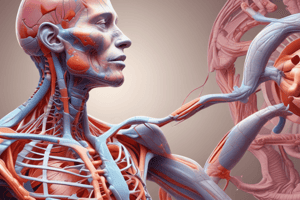Podcast
Questions and Answers
What is translatory motion and how does it differ from rotational motion?
What is translatory motion and how does it differ from rotational motion?
Translatory motion is the movement of an object along a straight line or a curved path, where all points on the object move in the same direction at the same speed. It differs from rotational motion, where an object rotates around an axis and points on the object move in circular paths.
Define uniform translatory motion and provide an example.
Define uniform translatory motion and provide an example.
Uniform translatory motion is when an object moves in a straight line at a constant velocity with no change in speed or direction. An example is a car driving steadily on a straight highway.
What equations are commonly used in kinematics to describe translatory motion?
What equations are commonly used in kinematics to describe translatory motion?
Common kinematic equations include: 1) $v = \frac{(x_f - x_i)}{(t_f - t_i)}$ for average velocity, 2) $v_f = v_i + at$ for final velocity, 3) $x_f = x_i + v_it + \frac{1}{2}at^2$ for final position, and 4) $v_f^2 = v_i^2 + 2a(x_f - x_i)$ for final velocity without time.
Explain how Newton's second law relates to translatory motion.
Explain how Newton's second law relates to translatory motion.
How does mass affect the translatory motion of an object?
How does mass affect the translatory motion of an object?
What is the role of friction in translatory motion?
What is the role of friction in translatory motion?
Describe an example of non-uniform translatory motion.
Describe an example of non-uniform translatory motion.
What factors determine the net force acting on an object in translatory motion?
What factors determine the net force acting on an object in translatory motion?
How can the kinematics of translatory motion apply to a rocket launching into space?
How can the kinematics of translatory motion apply to a rocket launching into space?
What does it mean for an object's orientation to remain constant in translatory motion?
What does it mean for an object's orientation to remain constant in translatory motion?
Flashcards
Translatory Motion
Translatory Motion
The movement of an object along a straight or curved path where all points on the object move in the same direction and at the same speed.
Uniform Translatory Motion
Uniform Translatory Motion
An object moving with a constant velocity in a straight line.
Non-Uniform Translatory Motion
Non-Uniform Translatory Motion
An object's velocity changes over time, resulting in acceleration.
Kinematics
Kinematics
Signup and view all the flashcards
Velocity
Velocity
Signup and view all the flashcards
Acceleration
Acceleration
Signup and view all the flashcards
Newton's Second Law
Newton's Second Law
Signup and view all the flashcards
Mass
Mass
Signup and view all the flashcards
Friction
Friction
Signup and view all the flashcards
Average Velocity
Average Velocity
Signup and view all the flashcards
Study Notes
Translatory Motion
-
Translatory motion, also known as linear motion, describes the movement of an object along a straight line or a curved path. The object's position changes uniformly in all directions in space.
-
Key characteristics:
- All points on the object move in the same direction and at the same speed.
- The object's orientation remains constant throughout the motion.
- Displacement occurs in a single direction.
-
Types of translatory motion:
- Uniform translatory motion: An object moves with a constant velocity in a straight line. The rate of change in position with respect to time (velocity) remains constant.
- Non-uniform translatory motion: An object's velocity changes over time. There is acceleration. This can result from varying forces.
Kinematics of Translatory Motion
-
Kinematics equations describe the motion of an object without considering the forces causing the motion. Key variables are:
- Position (x): The object's location in a chosen coordinate system.
- Time (t): The duration of the motion.
- Velocity (v): The rate of change of position with respect to time.
- Acceleration (a): The rate of change of velocity with respect to time.
-
Equations commonly used:
- v = (xf - xi) / (tf - ti) : average velocity calculation.
- vf = vi + at : final velocity calculation, given initial velocity and acceleration.
- xf = xi + vit + ½at2 : final position calculation.
- vf2 = vi2 + 2a(xf - xi): final velocity without time.
Factors Affecting Translatory Motion
-
Forces:
- A net force acting on an object causes acceleration.
- The relationship is described by Newton's second law: F = m*a
-
F is the resultant force, m is the mass, and a is the acceleration.
-
Mass:
- Greater mass requires greater force to achieve the same acceleration.
- Mass is a measure of an object's inertia, its resistance to changes in motion.
-
Friction:
- Frictional forces oppose motion.
- They can significantly reduce the speed of an accelerating/moving object.
- Often described in terms of a coefficient of friction.
Examples of Translatory Motion
-
Simple examples:
- A car moving along a straight road at constant speed.
- A ball falling vertically under the influence of gravity.
-
More complex examples:
- A rocket launching into space
- Planetary motion, while often described as an orbit, can be described as a translatory component relative to a larger body.
- Projectile motion, like a thrown ball, combines vertical and horizontal (independent) translatory motion components.
Studying That Suits You
Use AI to generate personalized quizzes and flashcards to suit your learning preferences.




